
Sir Henry Hallett Dale was an English pharmacologist and physiologist. For his study of acetylcholine as agent in the chemical transmission of nerve pulses (neurotransmission) he shared the 1936 Nobel Prize in Physiology or Medicine with Otto Loewi.
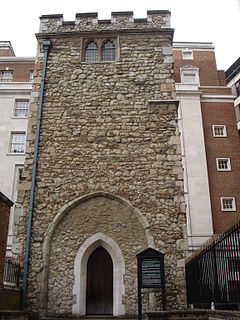
All Hallows Staining was a Church of England church located at the junction of Mark Lane and Dunster Court in the north-eastern corner of Langbourn ward in the City of London, England, close to Fenchurch Street railway station. All that remains of the church is the tower, built around AD 1320 as part of the second church on the site. Use of the grounds around the church is the subject of the Allhallows Staining Church Act 2010.
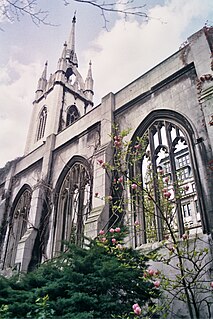
St Dunstan-in-the-East was a Church of England parish church on St Dunstan's Hill, halfway between London Bridge and the Tower of London in the City of London. The church was largely destroyed in the Second World War and the ruins are now a public garden.

Kenwood House is a former stately home in Hampstead, London, on the northern boundary of Hampstead Heath. The house was originally constructed in the 17th century and served as a residence for the Earls of Mansfield during the 18th and 19th centuries.
Samuel Sanders Teulon was a 19th-century English Gothic Revival architect, noted for his use of polychrome brickwork and the complex planning of his buildings.

Sulgrave Manor, Sulgrave, Northamptonshire, England is a mid-16th century Tudor hall house built by Lawrence Washington, the great-great-great-great grandfather of George Washington, first President of the United States. The manor passed out of the hands of the Washington family in the 17th century and by the 19th had descended to the status of a farmhouse. In 1911, Theodore Roosevelt, the former president, suggested a memorial to commemorate 100 years of peace between England and the United States, and the manor was bought for this purpose in 1914. Between 1920-1930 the manor was restored, and a garden created, by Reginald Blomfield. Sulgrave Manor is now administed by a trust and is a Grade I listed building.

Ormeley Lodge is a Grade II* listed early 18th-century Georgian house, set in 6 acres (2 ha) on the edge of Ham Common, near to Richmond Park in Ham, London. It is owned by Lady Annabel Goldsmith.

There are 72 Grade II* listed buildings in the city of Brighton and Hove, England. The city, on the English Channel coast approximately 52 miles (84 km) south of London, was formed as a unitary authority in 1997 by the merger of the neighbouring towns of Brighton and Hove. Queen Elizabeth II granted city status in 2000.

In London, the Greyfriars was a Conventual Franciscan friary that existed from 1225 to 1538 on a site at the North-West of the City of London by Newgate in the parish of St Nicholas in the Shambles. It was the second Franciscan religious house to be founded in the country. The establishment included a conventual church that was one of the largest in London; a studium or regional university; and an extensive library of logical and theological texts. It was an important intellectual centre in the early fourteenth century, rivalled only by Oxford University in status. Members of the community at that time included William of Ockham, Walter Chatton and Adam Wodeham. It flourished in the fourteenth and fifteenth century but was dissolved in 1538 at the instigation of Henry VIII as part of the Dissolution of the Monasteries. Christ's Hospital was founded in the old conventual buildings, and the church was rebuilt completely by Sir Christopher Wren as Christ Church Greyfriars after the original church was almost completely destroyed in the Great Fire of London of 1666. The building now standing on the site, designed by Arup Group Limited, is currently occupied by Merrill Lynch.
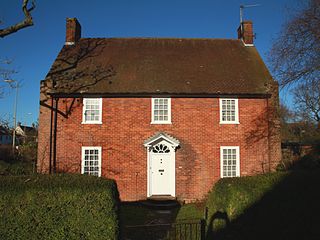
Thomas Lawrence Dale, FRIBA, FSA was an English architect. Until the First World War he concentrated on designing houses for private clients. From the 1930s Dale was the Oxford Diocesan Surveyor and was most noted for designing, restoring, and furnishing Church of England parish churches.

Adelaide Crescent is a mid-19th-century residential development in Hove, part of the English city and seaside resort of Brighton and Hove. Conceived as an ambitious attempt to rival the large, high-class Kemp Town estate east of Brighton, the crescent was not built to its original plan because time and money were insufficient. Nevertheless, together with its northerly neighbour Palmeira Square, it forms one of Hove's most important architectural set-pieces. Building work started in 1830 to the design of Decimus Burton. The adjacent land was originally occupied by "the world's largest conservatory", the Anthaeum; its collapse stopped construction of the crescent, which did not resume until the 1850s. The original design was modified and the crescent was eventually finished in the mid-1860s. Together with the Kemp Town and Brunswick Town estates, the crescent is one of the foremost pre-Victorian residential developments in the Brighton area: it has been claimed that "outside Bath, [they] have no superior in England". The buildings in the main part of Adelaide Crescent are Grade II* listed. Some of the associated buildings at the sea-facing south end are listed at the lower Grade II.
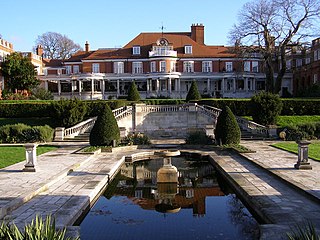
Inverforth House is a large detached house at North End Way on the outskirts of Hampstead in the London Borough of Camden, NW3. Owned by William Lever, 1st Viscount Leverhulme from 1904 to 1925, The Hill was bought by Andrew Weir, 1st Baron Inverforth after Leverhulme's death in 1925, and following was given to Manor House Hospital after Inverforth's death in 1956. Inverforth House was home to the Orthopaedic Society Hospital from the 1950s to the 1980s, and was converted into two houses and seven apartments in the late 1990s.

Romney's House at 5 Holly Bush Hill, Hampstead, Camden, London was the home of the artist George Romney and then of the architect Clough Williams-Ellis. It is a Grade I listed building.

Orchards is an Arts and Crafts style house in Bramley in Surrey, England. It is on Bramley's boundary with Busbridge and 1 mile (1.6 km) south-east of Godalming town centre. Described by English Heritage as the first major work of architect Edwin Lutyens, it is a Grade I listed building. The gardens are Grade II* listed in the National Register of Historic Parks and Gardens. The property is privately owned.
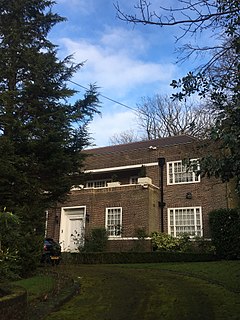
Spaniards Mount at 61 Winnington Road in Hampstead Garden Suburb, London is a detached house that was designed by the architect Adrian Gilbert Scott as his personal residence. It was built in 1935 and has been Grade II listed on the National Heritage List for England since November 1996.

Abernethy House at 7 Mount Vernon is a house in Hampstead in the London Borough of Camden. It has been listed Grade II on the National Heritage List for England (NHLE) since May 1974. It was originally built as a girls school around 1819. It is a 2-storey house with attics with a double front with 3 windows. A wooden door case surrounds the central entrance.
As of February 2001, there were 1,124 listed buildings with Grade II status in the English city of Brighton and Hove. The total at 2009 was similar. The city, on the English Channel coast approximately 52 miles (84 km) south of London, was formed as a unitary authority in 1997 by the merger of the neighbouring towns of Brighton and Hove. Queen Elizabeth II granted city status in 2000.

Church Row is a residential street in Hampstead in the London Borough of Camden. Many of the properties are listed on the National Heritage List for England. The street runs from Frognal in the west to Heath Street in the east. St John-at-Hampstead and its additional burial ground is at the west end of the street.

Moreton House is a detached house on Holly Walk in Hampstead in the London Borough of Camden. It has been listed Grade II on the National Heritage List for England (NHLE) since December 1969.

















